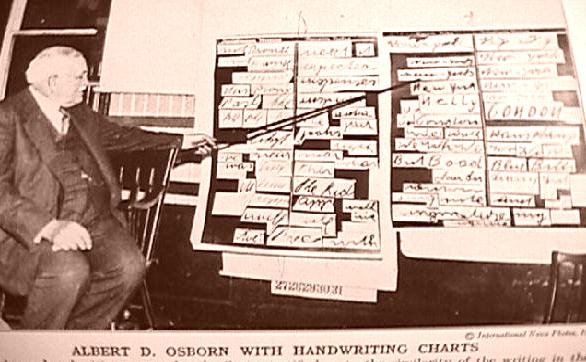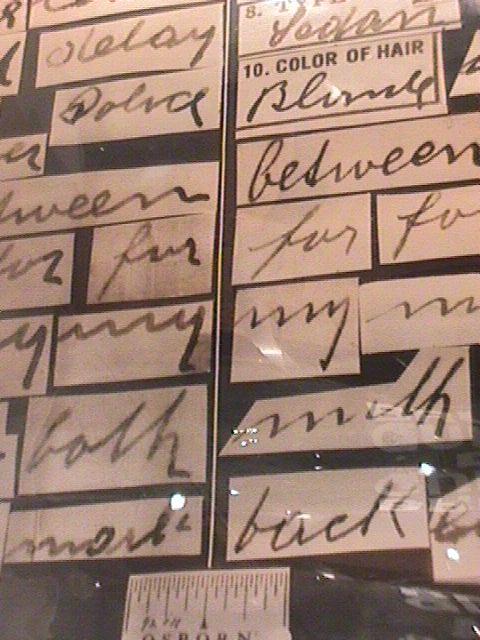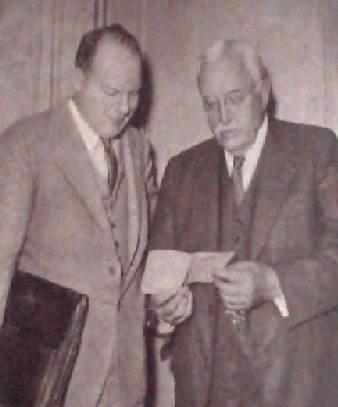

![[ACLU Execution Watch
Counter]](http://www.aclu.org/graphics/dpcounter.gif)
Directory Books Search Home Transcript Sources
![]() Lindbergh
Kidnapping Hoax Forum
Lindbergh
Kidnapping Hoax Forum
![]() Ronelle Delmont's
Lindbergh Kidnapping Hoax
You Tube Channel
Ronelle Delmont's
Lindbergh Kidnapping Hoax
You Tube Channel
Is Handwriting Analysis a Legit Science ? Click Here for The Straight Dope

Albert Osborn was one of several handwriting experts who testified that Hauptmann's handwriting showed similarities to the handwriting in the ransom letters. Although none of these "experts" ever linked Hauptmann's handwriting to the original nursery note no one seemed to notice - (please refer to the LKH Forum arguments below.)
Defense attorney, Ed Reilly, never knew that Osborn had originally told the Police that Hauptmann did not write the ransom note left in the nursery.
Pressured by Police into testifying that the handwriting was the same Osborn eventually changed in his "expert" opinion AFTER ransom money was discovered in Hauptmann's garage.
Osborn's reputation flourished due to this trial and his descendants still carry on the family business of selling their expertise in the realm of questioned document analysis.

In the 1970s McGraw-Hill was tricked into believing that an autobiography of Howard Hughes was authentic and actually written by the eccentric billionaire. Based upon the Osborn's authentication the publisher gave author Clifford Irving, who claimed to be Hughes's ghostwriter, a $750,000 advance. Hughes, a recluse from society, finally came forward and denied writing the book or even knowing Irving.
The book was discovered to be a fake, in spite of the Osborn approval, and Irving and his wife later pleaded guilty to criminal charges in connection with the incident.
Handwriting Arguments on the LKH Public Forum
Photos above and below were taken by Ronelle Delmont at the Trenton Police Museum in May 2001.

Michael Melsky
Sun
Aug 19 2001
(New
York Times Sept 22).
(Kennedy
180).
Hunterdon
County Democrat 1-17-35:
"...when
Reilly launched a popular tack of the defense, inquiring into the expenses of
hiring the expert witness. Restrained by the court, the witness did not tell how
much he (Osborn) was being paid."
Trenchard
disallows question by defense concerning the amount of money he (Osborn) would
be paid for his testimony. However we know that Albert S. and Albert D. put in
expense bills for $12,000 and $9,655 respectively putting the total bill for
handwriting testimony up to $46,661.15, a third of the hearing's total
expenditures
(Behn
252).
Osborn(s):
1.
(On the night of Hauptmann's arrest) Noted similarities but many distinct
differences. Refuses to make a positive connection. (Later changing his
position).
2.
Claimed the notes written in a disguised hand.
3.
Was not told and refused to believe the request writings were dictated and
written down as they appeared in the note (including style and misspellings).
Actually claimed Hauptmann "reverted" back to his disguised hand when
making the request writings.
4.
Claimed Geissler's handwriting was similar to the JJ Faulkner deposit slip (in
support of Souder's claim).
5.
Claimed never to have before seen a hyphen between New and York. (Prompting
Fisher to produce letters from Isidor Fisch with this same hyphen).
6.
Fisher produces cases where Osborn's testimony was incorrect.
7.
Claims Hauptmann had only one disguised hand.
8.
Claims Hauptmann had a unique way of making an "x".
9.
Stein contradicts this by saying Hauptmann's "x" was "a garden
variety".
10.
Tyrell contradicts this by admitting to Pope that the letter "x"
"appeared in three different forms in the ransom letters and acknowledged writings" of Hauptmann.
11.
Trenchard disallows question by defense concerning the amount of money he would
be paid for his testimony.
Souder:
1.
Originally said JJ Faulkner deposit slip matched Geisslers known handwriting.
This was supported by Osborn. (Before Hauptmann)
2.
Conceded on the stand there were "differences" between Hauptmann's
handwriting and the ransom notes.
3.
Admitted on the stand that he selected certain letters from the two sets of
documents for his exhibits showing "similarities" and
"discarded" others that were "dissimilar" because they
happened to be another type of letter.
Tyrell:
1.
Contradicts Osborn's "x" testimony
2.
Contradicts Osborn's "t" crossing testimony
3.
Admitted to Pope he had been "mistaken" in a forgery case (which sent
a man to jail until another confessed).
4.
Pope asked if the use of "may" and "packet" in the letters
indicated good usage by the ransom writer - Tyrell agreed...
5.
Admitted it was "significant" that the ransom writer spelled several
large words correctly but misspelled smaller less difficult ones.
Sellers:
1.
Admits to Pope that many of the same letters in his exhibit showing
similarities, could be substituted with other of the same letters written
elsewhere in the note, to produce an exhibit very dissimilar and unlike the one
he was showing.
2.
Like Tyrell, admits being struck by the many differences in the note to
Hauptmann's known handwriting.
Cassidy:
1.
Refused to believe the nature in which the request writings were produced.
Stein:
1.
Stein admits that in his study of the handwriting specimens he had paid
particular to similarities but had ignored dissimilarities.
2.
Stein stated that Hauptmann writes a number of letters in a style different from
that of the ransom notes, notably his "r", "l", and the
ending of his "s".
3.
Fisher also pointed out that Hauptmann, in the conceded handwriting specimen,
had spelled "not" correctly four times.
4.
Did not know the nature of the request writings.
5.
Contradicts Osborn's testimony - regarding the "x" as a "garden
variety".
6.
Testified that the ransom note writer used a more vertical hand then Hauptmann's.
Walters:
1.
Previously stated that there was an attempt at disguise in the ransom letters.
2.
Later stated the range of variation in the ransom notes is within the scope of
variation demonstrated by Hauptmann in the request and conceded writings.
3.
HCD 1-17-35: Rosencrans had Walters copy the word "two" as it appears
in Hauptmann's conceded writings. He produced a copy that showed a "strong
similarity", despite his protest that he was a poor imitator. Then
Rosencrans forced from the expert an opinion that a person familiar with German
characters could probably have been even more successful in the imitation.
(Kennedy
page 280):
"I
am going on faith," said Cassidy. "I have got a certain amount of
faith in humanity and I just can't think those officers would do a trick like
that."
Osborne
Jr. echoed him. "I cannot believe that the people getting those specimens
would do anything like that."
The
jury didn't believe it either. And yet that is what had happened...
Kennedy
page 318:
Trendley:
"I wouldn't take anything written in a police station, you would spell what
they told you to spell. Trendley added that the word expenses, when examined
under the microscope, appeared to have been written over....worked over."
Michael Melsky
Tue Feb 5 2002
Gunther P. Haas Report - March, 1983

(omit)
The differences between the ransom writing and Hauptmann's writings which have
been pointed out in this report are very prominent and , I submit, far
outweigh occasional similarities to which the reader's attention has been
drawn.
(omit)
In my view it would have been impossible for Hauptmann to write as the writer
of the ransom notes did, or vice-versa.
(omit)
Some of the differences I have found in comparing Hauptmann's writings with
the ransom note writings have bben quite startling. Hauptmann's use of the
letter "d" for instance is quite unlike anything in the ransom notes; for not
only does he frequently end the letter with a downstroke well below the line,
but the line becomes thinner instead of showing pressure which is more normal.
Differences in the figure "o". the capitals "B" and "S" and the small "k" are
equally startling.
I conclude this summary by re-affirming my opinion that the ransom letters
were not written by Hauptmann.
Kennedy 418:
(Published conclusions of) American handwriting expert, Mr. Gus R. Lesnevich,
formerly a documents examiner in the US army and US Secret Service....
"An examination, comparison and analysis of the questioned ransom notes and
known writings not used by the police, along with the additional known
writings, has resulted in the conclusion that Mr. Richard Hauptmann did not
write the questioned ransom notes."
bob
mills for the whole forum crowd
germans, or americans who speak that way
Sat Dec 7 2002
I've kept silent on the handwriting debate, because I know nothing about
graphology, and don't want to sound foolish. But a key question, and possibly
the key to determining Hauptmann's guilt or innocence as a kidnapper/murderer,
is "Did a German write them, or an American trying to sound like a
German?"
I refer everyone to the bandleader from NORTH DAKOTA, Lawrence Welk, who was
such a beloved AMERICAN that they tried to build a taxpayer-funded memorial to
him up there.
Welk never lived in Germany in his life. Yet at age 65, he was still saying
things on TV like "Tank you, tank you frentz-um-um" and "Dere dey
are, de luffly dancing couple, Bobby unt Barbara. Wunnerful, wunnerful."
The point is, Welk knew how to speak unaccented English. But he didn't want to
do so, maybe because he thought speaking with a German accent made him sound
more like Wagner...or Mozart. But there's no evidence that Welk ever WROTE THAT
WAY. I've never seen a sample of his writing, but I'll bet anything it isn't
filled with "Tank yous" and "Dere dey ares."
If one speaks with a German dialect, but has become accustomed to writing in
English (unlike Welk, Hauptmann was born in Germany, but he'd been in the United
States for almost ten years in 1932), would he naturally translate idiomatic
German speech into writing? I doubt it. He might SAY "anyding," but
would he write it that way? Or would he write "anything," but
pronounce it "anyding?"
Just asking. Oh, by the way, would somebody "Plees-a turn off da bubble
machine?"
Please visit :
![]() Lindbergh
Kidnapping Hoax Forum
Lindbergh
Kidnapping Hoax Forum
![]() Ronelle Delmont's
Lindbergh Kidnapping Hoax
You Tube Channel
Ronelle Delmont's
Lindbergh Kidnapping Hoax
You Tube Channel
ronelle@LindberghKidnappingHoax.com
![]() Michael
Melsky's
Lindbergh Kidnapping Discussion Board
Michael
Melsky's
Lindbergh Kidnapping Discussion Board
© Copyright Lindbergh Kidnapping Hoax 1998 - 2020